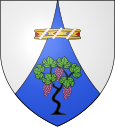Rocbaron
| Rocbaron | ||
|---|---|---|

|
|
|
| region | Provence-Alpes-Cote d'Azur | |
| Department | Var | |
| Arrondissement | Brignoles | |
| Canton | Garéoult | |
| Community association | Communauté de communes du Val d'Issole | |
| Coordinates | 43 ° 18 ' N , 6 ° 5' E | |
| height | 272-592 m | |
| surface | 20.28 km 2 | |
| Residents | 5,033 (January 1, 2017) | |
| Population density | 248 inhabitants / km 2 | |
| Post Code | 83136 | |
| INSEE code | 83106 | |
| Website | http://www.citaenet.com/rocbaron/ | |
 Ruins of the former castle |
||
Rocbaron is a French municipality with 5033 inhabitants (at January 1, 2017) in the department of Var in the region Provence-Alpes-Cote d'Azur . It belongs to the canton of Garéoult in the Arrondissement of Brignoles .
geography
Rocbaron lies in a landscape characterized by low hills, wooded with pine and chestnut trees . Rocbaron can be reached from Puget-Ville, an average of 200 m below, via a steep, winding road through the Bois d'Astros .
The French long-distance hiking trail GR9 from Saint-Amour via Léoncel to Saint-Tropez crosses the municipality.
history
The area of the municipality was already settled in prehistoric and Roman times. A village with the current name is first documented as De Rocabarone in 1019 and possibly points to a gentleman named Rocca de Baron . Later the place belonged to the counties of Marseille , Agoult, Vins, Forbin and Villeneuve.
Population development
The population development of the municipality over the last 40 years of the 20th century is remarkable. At the beginning of the 1960s there were still fewer than 100 people living in the village, whose population increased more than thirty-fold by the turn of the millennium as a result of an influx that has been increasingly observed since the 1980s.
Population development
| year | 1962 | 1968 | 1975 | 1982 | 1990 | 1999 | 2006 | 2017 |
| Residents | 99 | 222 | 310 | 778 | 1774 | 3026 | 3264 | 5033 |
| Sources: Cassini and INSEE | ||||||||
Buildings and sights
The old town center is well preserved. On a slight hillside, there are old houses, built in a style typical for the region. The bell tower with a small campanile dates from 1887. An old gate in the Rue des Fayssonnes dates from the 16th century.
In the immediate vicinity of the village stand on a rocky ledge the ruins of the Château de Saint-Sauveur , its polygonal keep with the notches for the archers, the lined up living rooms and the castle chapel from the 13th century.
The parish church of Saint-Sauveur dates from the 18th century and was renovated in the 19th century.
The community estate of La Verrerie is nearby . There you can see the remains of a lime kiln, coal-burning huts, the former sheepfold and a stone bridge.
